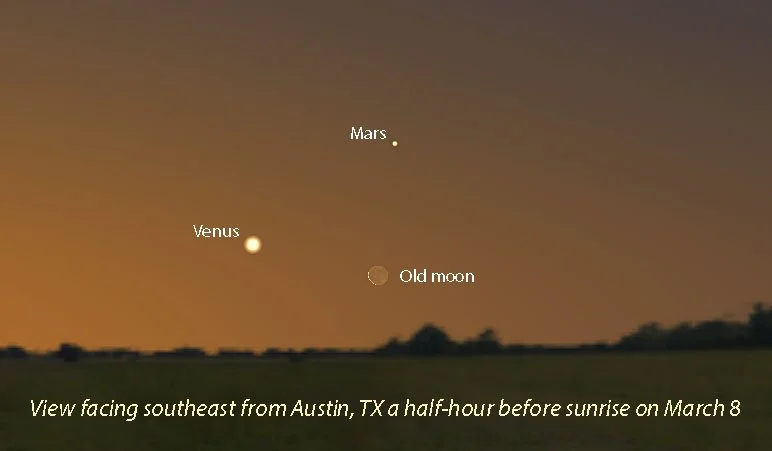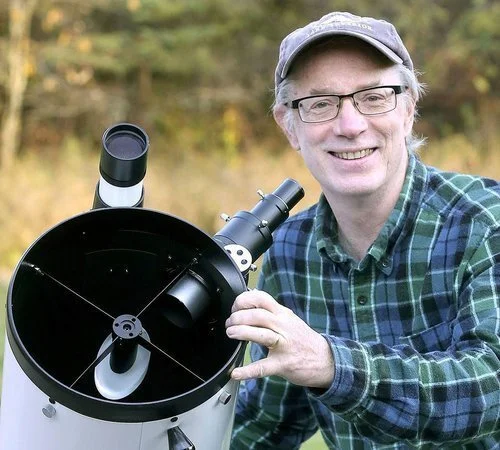March 2024 Night Sky Calendar
If you’ve followed this column this season, you’re already familiar with the Winter Hexagon, a six-sided pattern of bright stars centered on Orion the Hunter. In March the figure finally tilts into the southwestern sky as two early-spring luminaries take its place in the eastern sky — Regulus in Leo the Lion and Arcturus in Boötes the Herdsman.
Regulus shines above halfway up in the east around 8 p.m. local time at mid-month. It’s the only bright star visible in that direction at that hour. Orangey-red Arcturus, an even brighter star, makes it appearance around 10 p.m. low in the northeast. To find it just follow the arc of the Big Dipper’s handle downward and you’ll run right into it — arc to Arcturus, as we say.
Jupiter is still the only bright nighttime planet and dominates the southwestern sky at nightfall. At mid-month it sets about 2 hours after evening twilight ends. During the second half of March, Mercury pops out of the solar glare and makes its best evening appearance of the year at dusk.
Venus is very low in the southeastern sky at dawn as the month opens and then disappears in the twilight glow. Mars remains stuck in morning twilight all month and very low in the southeastern sky. You’ll need binoculars for a good look.
Special events in March include a comet visit and a lunar penumbral eclipse. Comet 12P/Pons-Brooks will be visible in 7x35 or 10x50 binoculars (or similar) from a reasonably dark location at the end of evening twilight low in the northwestern sky. You should see a fuzzy blob — that’s the comet’s head — with a short tail pointing back to the east.
During a penumbral eclipse the moon passes through Earth’s outer shadow called the penumbra so its “bite” isn’t as dark and obvious. Still, this eclipse will be a deep one with 96 percent of the moon engulfed in the penumbra, making the shadow easy to spot especially around the time of greatest eclipse. Would that it would happen at a more convenient hour!
(Stargazing tip: To help you find stars and constellations, download the free Stellarium Mobile app for Android and iPhone. Just do a Google search then install the app, set it in night mode (red screen) and point your phone skyward.)
Events (a.m. indicates the event happens in the early morning sky):
March 1-15 – Best time to spot Comet 12P/Pons-Brooks before moonlight interferes. The “P” stands for periodic, meaning this is a returning comet. Its last visit was in 1954. I’ll post a finder map on Facebook (facebook.com/astrobobking ) at the start of the month.
March 3 (a.m.) – Last quarter moon. Watch for it to rise around 1:30 a.m. right next to the bright, red star Antares in Scorpius. Observers in the southeastern U.S. will see the moon occult (hide) the star, while Midwesterners can watch Antares emerge from behind the moon’s dark edge at or just after moonrise. More details in my Facebook and here: lunar-occultations.com/iota/bstar/0303zc2366.htm
March 8 – Super-thin crescent moon forms a compact triangle with Venus and Mars very low in the southeastern sky a half-hour before sunrise. A nice triple gathering and probably the last time to spot Venus in the morning. Too low for northern U.S. observers but visible from the southern third of the country. Use binoculars. Find your local sunrise time at timeanddate.com/sun/
March 10 – New Moon. The moon lies in the same direction as the sun and is not visible. Today also marks the start of Daylight Saving Time. Move clocks ahead 1 hour.
March 12-31 – The International Space Station (ISS) makes evening passes for northern mid-latitude viewers. Check spotthestation.nasa.gov/ for local times of its appearance.
March 13 – Crescent moon and Jupiter in conjunction just 3 degrees apart. Look for the pair in the western sky at dusk.
March 14 – Crescent moon hangs just 1.5 degrees below the Pleiades or Seven Sister star cluster in the western sky at nightfall. A fabulous sight in binoculars!
March (mid-month) – Brightest star Sirius due south at the end of dusk. Best twinkling star! When the air is especially turbulent Sirius twinkles in color, a sight further enhanced in binoculars.
March 15-31 – Mercury makes a great appearance low in the western sky at dusk. Look for a solitary bright star about 45 minutes to an hour after sunset. Find your local sunset time at timeanddate.com/sun/ to help plan your viewing session.
March 16 – First quarter moon. Stands high in the southern sky around sunset.
March 18 – Waxing gibbous moon just 3 degrees below the bright star Pollux in Gemini the Twins.
March 19 – Start of spring at 10:06 p.m. CDT. Day and night length are nearly equal across the planet.
March 21 – Waxing gibbous moon shines about 4 degrees north of Regulus, Leo the Lion’s brightest star.
March 24-25 (a.m.) – Full Worm Moon. The moon will rise to the east in Virgo around sunset. Find your local moonrise time at timeanddate.com/moon. We’ll also witness a penumbral eclipse overnight. The times below are Central Daylight viewing — add an hour for Eastern, subtract one hour for Mountain and two hours for Pacific times:
First obvious sign of the moon in penumbra — around 12:30 a.m. CDT (March 25) Greatest eclipse / deepest in shadow — 2:13 a.m. CDT Eclipse ends — 4:32 a.m. CDT
March 27-31 – Best nights to see the zodiacal light, a tapering, cone-shaped dust cloud that begins at the western horizon and reaches to nearly the top of the sky. Composed of comet, asteroid and Mars dust, the pancake-like cloud lies in the plane of the solar system. Best viewing time is 2 hours after sunset.
Bob King is an amateur astronomer, author, and passionate educator. He served as a photographer and photo editor at the Duluth News Tribune for 39 years and taught at the UMD planetarium. Bob’s work had a great impact on Voyageurs National Park. To achieve International Dark Sky Park certification, the park was required to host dark sky education events. Through the Night Sky Explorer webinars, the Conservancy was able to fulfill this component and help secure the certification for Voyageurs National Park. We can’t thank Bob King enough for sharing his talents and knowledge with the Conservancy community to support dark sky preservation.








